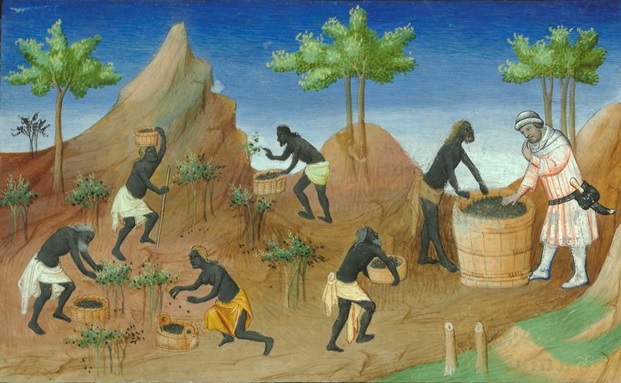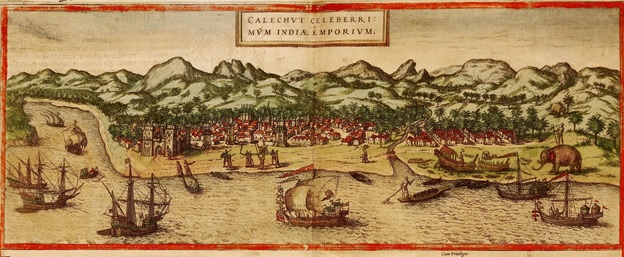History of Black Pepper

Black pepper is native to South Asia and Southeast Asia, and has been known to Indian cooking since at least 2000 BC. Its most important source was India, particularly the Malabar Coast, in what is now the state of Kerala. The lost ancient port city of Muziris in Kerala, famous for exporting black pepper and various other spices, gets mentioned in a number of classical historical sources for its trade with Roman Empire, Egypt, Mesopotamia, Levant, and Yemen. Peppercorns were a much-prized trade good, often referred to as “black gold” and used as a form of commodity money. The legacy of this trade remains in some Western legal systems that recognize the term “peppercorn rent” as a token payment for something that is, essentially, a gift. The ancient history of black pepper is often interlinked with (and confused with) that of long pepper, the dried fruit of closely related Piper longum. The Romans knew of both and often referred to either as just piper. In fact, the popularity of long pepper did not entirely decline until the discovery of the New World and of chili peppers. Chili peppers—some of which, when dried, are similar in shape and taste to long pepper—were easier to grow in a variety of locations more convenient to Europe. Before the 16th century, pepper was being grown in Java, Sunda, Sumatra, Madagascar, Malaysia, and everywhere in Southeast Asia. These areas traded mainly with China, or used the pepper locally. Ports in the Malabar area also served as a stop-off point for much of the trade in other spices from farther east in the Indian Ocean.
Ancient times
Black peppercorns were found stuffed in the nostrils of Ramesses II, placed there as part of the mummification rituals shortly after his death in 1213 BC. Little else is known about the use of pepper in ancient Egypt and how it reached the Nile from the Malabar Coast of South Asia.

Pepper was known in Greece at least as early as the fourth century BC, though it was probably an uncommon and expensive item that only the very rich could afford.
By the time of the early Roman Empire, especially after Rome’s conquest of Egypt in 30 BC, open-ocean crossing of the Arabian Sea direct to Chera dynasty southern India’s Malabar Coast was near routine. Details of this trading across the Indian Ocean have been passed down in the Periplus of the Erythraean Sea. According to the Greek geographer Strabo, the early empire sent a fleet of around 120 ships on an annual trip to India and back. The fleet timed its travel across the Arabian Sea to take advantage of the predictable monsoon winds. Returning from India, the ships travelled up the Red Sea, from where the cargo was carried overland or via the Nile-Red Sea canal to the Nile River, barged to Alexandria, and shipped from there to Italy and Rome. The rough geographical outlines of this same trade route would dominate the pepper trade into Europe for a millennium and a half to come.
With ships sailing directly to the Malabar coast, Malabar black pepper was now travelling a shorter trade route than long pepper, and the prices reflected it. Pliny the Elder’s Natural History tells us the prices in Rome around 77 CE: “Long pepper … is 15 denarii per pound, while that of white pepper is seven, and of black, four.” Pliny also complains, “There is no year in which India does not drain the Roman Empire of 50 million sesterces”, and further moralizes on pepper:
It is quite surprising that the use of pepper has come so much into fashion, seeing that in other substances which we use, it is sometimes their sweetness, and sometimes their appearance that has attracted our notice; whereas, pepper has nothing in it that can plead as a recommendation to either fruit or berry, its only desirable quality being a certain pungency; and yet it is for this that we import it all the way from India! Who was the first to make trial of it as an article of food? and who, I wonder, was the man that was not content to prepare himself by hunger only for the satisfying of a greedy appetite?
He does not state whether the 50 million was the actual amount of money which found its way to India or the total retail cost of the items in Rome, and, elsewhere, he cites a figure of 100 million sesterces. Black pepper was a well-known and widespread, if expensive, seasoning in the Roman Empire. Apicius’ De re coquinaria, a third-century cookbook probably based at least partly on one from the first century CE, includes pepper in a majority of its recipes. Edward Gibbon wrote, in The History of the Decline and Fall of the Roman Empire, that pepper was “a favorite ingredient of the most expensive Roman cookery”.
Postclassical Europe
Pepper was so valuable that it was often used as collateral or even currency. The taste for pepper (or the appreciation of its monetary value) was passed on to those who would see Rome fall. Alaric, king of the Visigoths, included 3,000 pounds of pepper as part of the ransom he demanded from Rome when he besieged the city in the fifth century. After the fall of Rome, others took over the middle legs of the spice trade, first the Persians and then the Arabs; Innes Miller cites the account of Cosmas Indicopleustes, who travelled east to India, as proof that “pepper was still being exported from India in the sixth century”. By the end of the Early Middle Ages, the central portions of the spice trade were firmly under Islamic control. Once into the Mediterranean, the trade was largely monopolized by Italian powers, especially Venice and Genoa. The rise of these city-states was funded in large part by the spice trade. It is commonly believed that during the Middle Ages, pepper was often used to conceal the taste of partially rotten meat. No evidence supports this claim, and historians view it as highly unlikely; in the Middle Ages, pepper was a luxury item, affordable only to the wealthy, who certainly had unspoiled meat available, as well. In addition, people of the time certainly knew that eating spoiled food would make them sick. Similarly, the belief that pepper was widely used as a preservative is questionable; it is true that piperine, the compound that gives pepper its spiciness, has some antimicrobial properties, but at the concentrations present when pepper is used as a spice, the effect is small. Salt is a much more effective preservative, and salt-cured meats were common fare, especially in winter. However, pepper and other spices certainly played a role in improving the taste of long-preserved meats.

Its exorbitant price during the Middle Ages – and the monopoly on the trade held by Italy – was one of the inducements that led the Portuguese to seek a sea route to India. In 1498, Vasco da Gama became the first person to reach India by sailing around Africa; asked by Arabs in Calicut (who spoke Spanish and Italian) why they had come, his representative replied, “we seek Christians and spices”. Though this first trip to India by way of the southern tip of Africa was only a modest success, the Portuguese quickly returned in greater numbers and eventually gained much greater control of trade on the Arabian Sea. The 1494 Treaty of Tordesillas with the Spanish granted Portugal exclusive rights to the half of the world where black pepper originated. However, the Portuguese proved unable to monopolize the spice trade. Older Arab and Venetian trade networks successfully imported enormous quantities of spices, and pepper once again flowed through Alexandria and Italy, as well as around Africa. In the 17th century, the Portuguese lost almost all of their valuable Indian Ocean trade to the Dutch and the English, who, taking advantage of the Spanish rule over Portugal during the Iberian Union (1580–1640), occupied by force almost all Portuguese interests in the area. The pepper ports of Malabar began to trade increasingly with the Dutch in the period 1661–1663.
As pepper supplies into Europe increased, the price of pepper declined (though the total value of the import trade generally did not). Pepper, which in the early Middle Ages had been an item exclusively for the rich, started to become more of an everyday seasoning among those of more average means.
China
It is possible that black pepper was known in China in the second century BC, if poetic reports regarding an explorer named Tang Meng are correct. Sent by Emperor Wu to what is now south-west China, Tang Meng is said to have come across something called jujiang or “sauce-betel”. He was told it came from the markets of Shu, an area in what is now the Sichuan province. The traditional view among historians is that “sauce-betel” is a sauce made from betel leaves, but arguments have been made that it actually refers to pepper, either long or black.
In the third century CE, black pepper made its first definite appearance in Chinese texts, as hujiao or “foreign pepper”. It does not appear to have been widely known at the time, failing to appear in a fourth-century work describing a wide variety of spices from beyond China’s southern border, including long pepper. By the 12th century, however, black pepper had become a popular ingredient in the cuisine of the wealthy and powerful, sometimes taking the place of China’s native Sichuan pepper.
Marco Polo testifies to pepper’s popularity in 13th-century China, when he relates what he is told of its consumption in the city of Kinsay (Hangzhou): “… Messer Marco heard it stated by one of the Great Kaan’s officers of customs that the quantity of pepper introduced daily for consumption into the city of Kinsay amounted to 43 loads, each load being equal to 223 lbs.” During the course of the Ming treasure voyages in the early 15th century, Admiral Zheng He and his expeditionary fleets returned with such a large amount of black pepper that the once-costly luxury became a common commodity.
